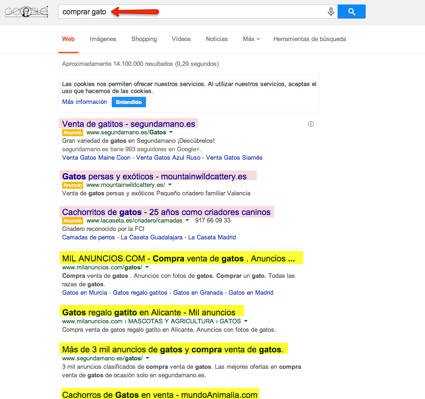Written by Fani Sánchez
Índice
Every search engine positioning strategy begins with the definition and choice of keywords. These represent the concepts with which we want our customers to identify us and the terms with which we want Google to classify us. It is very important that we choose them very carefully: a wrong choice would make us focus our efforts on keywords that will not bring us the desired profitability.
But where do I start?

The previous aspects to be taken into account are all closely related, and require us to have a good capacity for empathy and to know our audience perfectly well.
Define our target
The first step that we should have well defined when starting a keyword search and selection process is to know who our target audience is. When a user performs a search of any kind in search engines (information, products, services), he/she is motivated by a clear motivation or need. But there are different user profiles and each one, depending on their context, will search in a certain way.
To do this, we propose the exercise of defining “personas” for our target or target audience, so that we can identify the objectives, motivations, desires and limitations of each target subtype. This phase corresponds to a profound exercise of empathy.
Different user profiles
Among the target audience of a website or business, there can and usually are multiple profiles with:
Different needs.
- Different purchase motivations.
- Different stage of the purchase or contracting decision process.
- Different socioeconomic contexts.
- Different degree of knowledge of the product or service.
Let’s take an example. If we are talking about a user who is looking to buy a mobile terminal but is a neophyte in the subject, he will search for “best mobiles” or “latest model mobiles”. On the other hand, if he is already versed in the subject, he will probably search for “mobiles with 12mpx camera”, “quad-core mobiles” or any other more specific search formula that denotes that he knows better what he wants. If we go one step further in the user’s expertise and we talk about a regular consumer of this type of services or products, he/she will probably look for a specific brand and product, for example “Samsung Galaxy 4 price” or “Buy Xperia Z3”.
Search and brand terms
It is also advisable to consider some branded searches, especially when our brand competes with vertical search engines such as Trivago, Tripadvisor or Booking. Vertical search engines are search engines specialized in a specific market niche (hotels and flights, vacation packages, restaurants).
If there are vertical search engines in your industry, keep in mind that you will be competing with them in branded searches
For example, if I have a restaurant “X” I should consider searches such as “Restaurant X reviews” or if I have a hotel “Y”, consider searches such as “Book hotel room Y”, “Hotel Y prices”.
Anticipatory searches
Anticipatory searches correspond to the first stage of the conversion funnel: discovery.
Anticipatory searches are conditioned by the stage of the conversion funnel they are in: the discovery stage, the first of them.
These searches can be very generic or, on the contrary, very specific. These searches tend to be mainly aimed at mapping the content part of a website, suggesting topics of interest to our target audience.
Some examples of anticipatory searches:
- If we are planning a trip: Romantic destinations, Rural getaways, Plans for vacations with children.
- If we are thinking of buying a car: fuel-efficient cars, best car brands.
Jergas
It is also important to keep in mind that in many occasions the words with which clients search for us are not the same as the ones we use to name our services.
Because we are experts in our field, we lose sight of the customer’s perspective and end up forgetting that our jargon will not normally match theirs.
For example, if a teenager wants to obtain a moped license, he or she will most likely type the formulas “moped license”, “moped permit” or “moped license”. He will hardly know that “license” is an officially obsolete term and that the correct word is “permit” or that since the last reform the name of the traditional moped license was changed to “AM permit”.
The more terms that match the searches typed by our potential audience, the more users will reach our website. And they will be users who are really looking for what we offer and therefore, quality traffic with a high probability of conversion or loyalty.
Empathy

Are we targeting an expert or inexperienced audience? Is your search motivation to solve a problem? Searching for symptoms of the same? These are just some of the questions we should ask ourselves to make our list.
The tools available are only a support point: for this work, it is recommended that the following be used talk to trusted customersorganize discussion groups (or focus groups) encouraging participation, use customer service to obtain information or even ask family and friends for help how they would seek your services.
Correspondence with our content
The list of keywords chosen must have a correspondence with our web content, or the possibility of generating this correspondence by creating content. Otherwise, the situation would be comparable to any physical store that advertises products or services that it does not really have. And the result of this situation can be extrapolated to the online world: the user is attracted by this ‘misleading’ advertising (keywords without correspondence), arrives at the store (website), does not find what he/she is looking for, feels cheated or frustrated and leaves. And not only that, he will most likely never set foot in your store again.
The chosen keywords should be as close as possible to the actual offer and content of your web site
We can also choose keywords for which we have the possibility to create content. For example, I have an online shoe store and I don’t currently sell ‘t-shirts’ or ‘flip-flops’. If during the keyword research we find these terms and/or their derivatives interesting, we could consider starting to sell t-shirts, creating a new dedicated section and optimizing it for the formulas just found.
We can also incorporate very long tail terms in order to develop our content strategy in the blog: “combine heels and dresses”, or “shoes for a wedding”.
Polysemy and ambiguity of terms
There are polysemous words, i.e., words with several meanings, which out of context can lead to confusion.
For example, if we have an e-commerce selling tools and materials for do-it-yourselfers, we will have cats. And not that kind of fluffy, soft-eyed cat. A hydraulic jack. Then, we will have to think twice before trying to position ourselves for terms such as buy cat or cat types, because, surely, most users looking to buy a cat are referring to acquiring a feline. And for proof, a button: these are the results that appear in Google when searching for “buy cat”.
Although we only show part of the search results, I can confirm that 100% of them are trying to sell or give away a cute kitten.
In this case, we would opt for terms that disambiguate this polysemy, such as “hydraulic jacks”, “car jacks”, whether or not they have traffic potential.
Language context
By user language context we refer to counterpart languages where the geographical and cultural context is what separates them. For example, an English-speaking user in the United Kingdom does not have the same language context as an English-speaking user in the United States, Australia or Canada. Nor do users from Spain and users from Argentina have the same idiomatic context. Both speak Spanish, but a language gap separates them.
In order to situate the linguistic context of your audience, use the AdWords Keyword Planner and accompany it with a market study of your competitors in the country where you want to position yourself.
For this task, there are tools that suggest some terms according to the country, such as the AdWords Keyword Planner. But without a doubt, what will help you the most is market research. Locate your local competition and study the keywords they use on their site. because, surely, he is way ahead of you in that respect.
And it looked easy, didn’t it?
There are many angles from which the user’s motivation, needs and expertise are embodied in our key wordsIf we consider all of them in our keyword research, it will probably be easier for us to connect with our target audience.
Our success depends to a great extent on knowing how our potential consumers or clients search for our services in order to position ourselves by similar or equal search formulas and facilitate their access to our products.
 Different needs.
Different needs.



